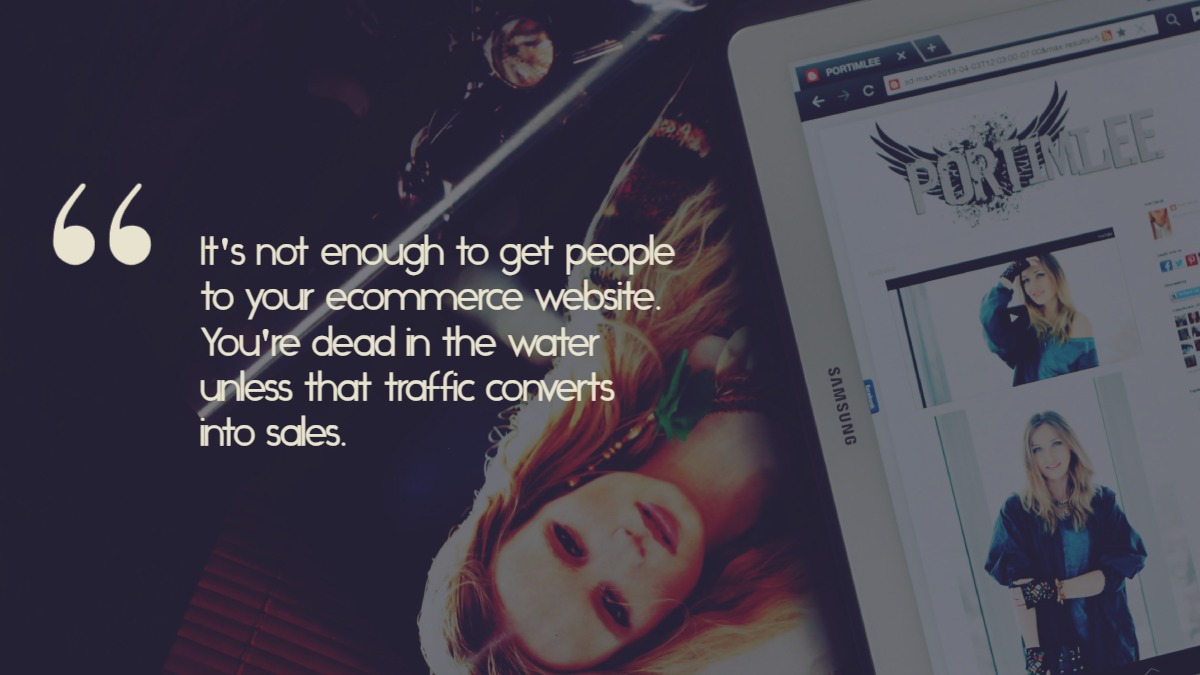Tips for improving your e-commerce conversion rate

This is a marketing truth: you can have the best advertising in the world, driving all sorts of traffic to your website… but if your website doesn’t convert that traffic into sales, you’re wasting your money.
Obvious, right?
It may be obvious, but I will say it again: it is absolutely imperative—especially if you’re an e-commerce company—that you focus on improving your website conversion rate.
First, let’s set the target. As a baseline, your e-commerce website is doing really well if it has a conversion rate of at least 3%*. This means that for every 100 people who visit your site, about three people will buy something (or, put another way, people make purchases about 3% of the time).
Is your conversion rate at or above 3%? Yes? Congratulations! The information below might still be helpful for you to increase your conversion rate even more. If you’re not at 3%, however, you definitely need to take some time and work on your online store. Here’s where you should focus:
Pricing: one of the most important decisions you can make as an e-commerce company.
Set your prices too high, and you’ll lose sales. Too low, and you’re leaving money on the table and reducing your margin. Test different pricing strategies, particularly on your top sellers. Do NOT arbitrarily set a price based on how much margin you want to make.
Shipping: high shipping costs cause sticker shock.
A sign that this is happening is if you see a large percentage of people abandon their cart after they have started checkout. If you can’t offer free shipping (and many e-commerce companies can’t), then offer free shipping on orders over a certain dollar amount.
Free returns: a generous return policy will go a long way if someone’s on the fence.
It’s a leap of faith to place an order for a product sight unseen. Customers are better able to make that leap of faith if they know they can return the item if it’s not what they expected.
Product selection: people won’t buy if they don’t like what you sell.
Obvious, right? But it pays to make sure you’re offering products that people want to buy (and make sure you’re advertising to the right audience). Remember, you may love your product, but other people won’t. Some market research is always a good idea so that you both test your concept and your audience. Want to read more on building your audience?
Product descriptions: provide all the information people need to buy.
Remember, people are buying your product without being able to touch and feel it. Make sure you answer any question they may have in the product description—and focus on the benefits to the customer (what do they get from it?) not what you see as your favorite features.
Photography: good product photography IS A MUST.
Don’t skimp. Show the product from multiple angles and (for clothing) on multiple models. Also, while the classic product-cut-out-against-a-white-background is a good idea, don’t forget to also show it styled; for instance, if you’re selling travel mugs, try a shot of the mug steaming against a vista in the wilderness. Aspiration is a good sales tool.
Site navigation: people won’t buy if they can’t find what they want.
Make sure your categories are clear and easy to navigate, and if you have a big catalog, add filters, search, and sort features. Not sure if your site is easy to navigate? Have a few people test it for you.
Social proof/UGC: people like to buy what other people buy.
Again (we’re a broken record, here), people can’t see your product in person—but knowing that other people have purchased (and loved it) will help them feel comfortable taking that leap of faith. Add product reviews from a third-party review generator like Trustpilot (don’t just add reviews yourself, if you can help it—those tend to look less real). Also, add user-generated content (UGC is photos and videos created by people who use your product) whenever you can. For our clients, we scan social media for photos of products “in the wild” and then add them to our product pages. Just remember to get permission. There are also platforms that do this automatically if you want to spend the bucks.
Offer coupon codes to new customers: a little incentive will change a browser to a customer.
The biggest hurdle is getting a site visitor to make their first purchase. Once they’ve ordered something (and, we’re assuming, liked the product and the service), they’ll likely be a customer for life. Consider first-time-customer discount codes to help them get over that hurdle.
Create a good conversion funnel: most people won’t buy the first time they visit.
Set up a system so you can keep reminding people about your product if they leave without buying. Get their email address by offering a coupon code (see above), then add them to your email list for weekly or monthly emails. Set up retargeting ads on social media and Google (retargeting ads are ads that are shown to people who have previously visited your website). Set up automatic email (and/or text, depending on your demographic) flows for cart and browse abandonment. If you don’t know how to do this, ask for help (we can help!), or read more on website conversion funnels.
Reduce form fields and make paying easy: don’t make people work hard to buy.
The last thing you want is someone deciding to buy that shirt on a whim, but then finding out they have to fill out a bunch of fields on their phone and have to get up off the couch for their credit card. Make buying easy! Integrate PayPal and other popular payment systems (platforms like Shopify make this easy), and keep your information fields to a minimum. And make it easy for people to save their information for fast checkout the next time. Similarly, avoid lots of disclaimers and warnings, since they tend to reduce trust.
Site speed: if it loads too slowly, you’ve already lost.
In a world of instant gratification, you’ll lose people if they have to wait too long for a page to load. Optimize your photographs and work with your web designer to improve your site speed (this is good for SEO, too).
Optimize for mobile: it’s 2024, people.
There’s an online plant nursery I buy from periodically that has a completely unresponsive website. Pull it up on your mobile, and it looks like the desktop site—just waaaay smaller. It’s a pain in the rear, and I hate them for it. Don’t do this to your customers, since only long-time, super-engaged customers (like me, in this case) will put up with it. Many of your customers will be browsing on mobile, so make sure the site isn’t just responsive, but actually functions and navigates well on mobile, including things like filters and payment fields. Test it thoroughly on multiple devices.
Provide good service: A friendly interaction goes a long way in building customer loyalty.
The last thing you want to do is lose a sale because the potential customer couldn’t get a question answered. Ideally, include help chat on your website; at the very least, have someone who answers the phone and emails promptly. And avoid harsh policies that make customers hate you. Sure, those harsh policies may save you money, but they’ll also likely lose you a lifetime customer… and maybe other potential customers if they complain about you in a review.
There you have it—website conversion 101 in a nutshell. Sure, it may look like a lot, but it’s mostly about one thing: giving people the confidence to buy a product they’ve never seen. Make it fast, make it easy, make it pleasant (and make sure your product and service are good) and the e-commerce world will be your oyster.
Happy marketing!
Katie & Theron
Urban Sherpa Marketing Company is a boutique marketing advisory firm specializing in helping small to medium-sized companies jumpstart their growth. Offering everything from outsourced marketing director services to marketing training and hiring advisory, they love helping marketing teams grow and thrive.
*For the purposes of this blog, we’re going to focus on e-commerce companies. B2B companies, SAAS companies, and D2C service companies will all have different conversion rate baselines.

